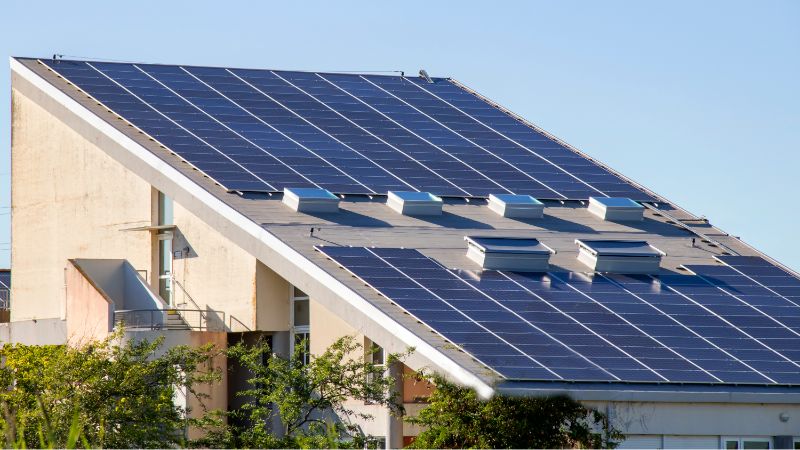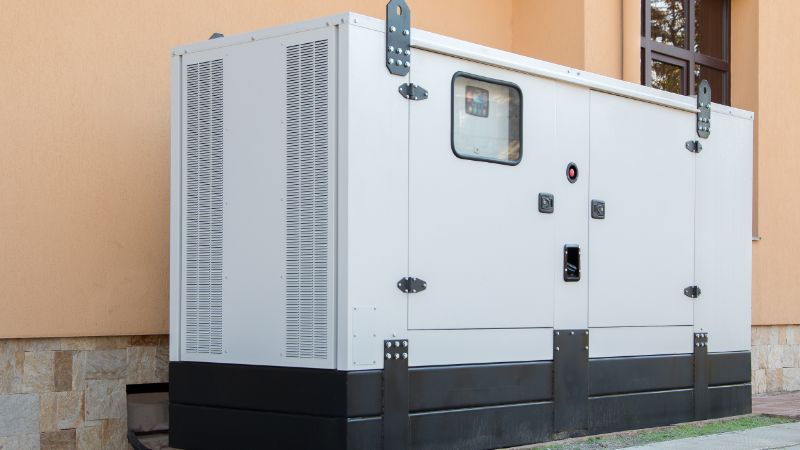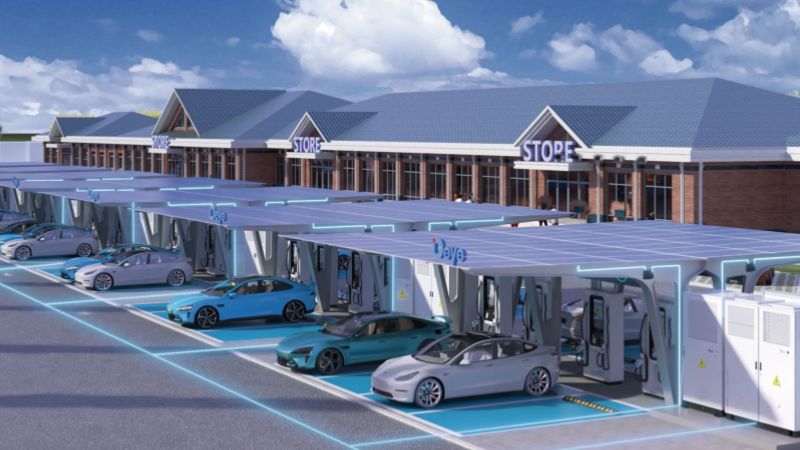A solar generator is an all-in-one portable power solution that combines solar panels, charge controller, battery, and inverter in a single unit, while a battery bank is a collection of batteries designed to store larger amounts of energy that requires separate components to function as a complete system.
For everyday users, this distinction matters because it affects portability, capacity, and overall system flexibility. Learn more in this article.

Understanding Solar Generators
Solar generators represent an all-in-one solution for portable power needs. THey offer convenience and simplicity for both emergency backup and off-grid applications.
How Solar Generators Work
Solar generators capture energy from the sun through photovoltaic panels, converting sunlight directly into electricity. This DC (direct current) electricity flows into the generator unit where a charge controller regulates the incoming power to prevent battery damage.
The energy is then stored in the internal battery – typically lithium-ion or lead-acid. When power is needed, the stored DC electricity passes through an inverter that converts it to AC (alternating current) electricity, compatible with standard household devices.
This process creates a continuous power cycle: solar collection during daylight hours, energy storage in batteries, and on-demand power distribution. Most modern solar generators also include multiple charging options beyond solar, such as wall outlets or car chargers for flexibility.
Core Components of a Solar Generator
- Solar Panels: Portable or fixed panels that capture sunlight and convert it to electricity. Panel wattage typically ranges from 50W to 200W for portable systems.
- Battery: The storage component, usually lithium-ion for newer models due to their lighter weight and longer lifespan. Battery capacity is measured in watt-hours (Wh) or amp-hours (Ah).
- Charge Controller: Regulates the voltage and current coming from solar panels to prevent overcharging and battery damage.
- Inverter: Converts the DC power stored in the battery to AC power used by most appliances. Inverter capacity (measured in watts) determines what devices can be powered.
- Outputs: Various ports including AC outlets, USB ports, and 12V car ports to connect different devices directly.
- Display/Controls: User interface showing battery status, input/output metrics, and system settings.
Typical Applications for Solar Generators
Solar generators excel in scenarios requiring temporary or mobile power solutions. They’re popular for camping and RV trips, providing clean energy for lights, phones, and small appliances without noise or emissions.
During power outages, they serve as emergency backup systems for essential devices like medical equipment, refrigerators, and communication tools. Their silent operation makes them preferable to gas generators in residential settings.
Construction sites and remote work locations utilize solar generators for power tools and equipment where grid access is unavailable. Many models are lightweight enough to be carried by one person, making them ideal for fieldwork.
Common Applications:
- Recreational activities (camping, boating, tailgating)
- Emergency home backup
- Remote work sites
- Off-grid cabins and tiny homes
- Outdoor events and festivals

Battery Banks Explained
Battery banks serve as energy storage systems that collect and store electricity for later use. They provide reliable power when grid electricity is unavailable or during peak usage times.
Types of Battery Banks
Lead-acid batteries remain popular for battery banks due to their affordability and reliability. These traditional options come in flooded (requiring maintenance) and sealed varieties (maintenance-free), with the latter being more suitable for indoor use.
Lithium-ion batteries have revolutionized energy storage with their higher energy density and longer lifespan. While more expensive initially, they often prove more cost-effective over time due to their 3000+ cycle capability compared to lead-acid’s 500-1000 cycles.
Other options include nickel-cadmium (NiCd) batteries, known for durability in extreme temperatures, and flow batteries that excel in large-scale applications. Saltwater batteries represent an emerging eco-friendly alternative without toxic chemicals.
How Battery Banks Function
Battery banks store electricity as chemical energy and convert it back to electrical energy when needed. The system typically includes multiple batteries connected in series (to increase voltage) or parallel (to increase capacity) configurations.
A charge controller regulates the electricity flowing into the batteries, preventing overcharging and extending battery life. This component is crucial for safe operation, especially when charging from solar panels or other variable sources.
Key Components:
- Batteries (connected in series/parallel)
- Charge controller
- Inverter (converts DC to AC power)
Battery monitor (tracks charge status)
During discharge, the stored chemical energy converts back to electricity, flowing through an inverter if AC power is needed for standard household appliances.
Battery Bank Use Cases
- Home Backup Power:Battery banks provide critical power during outages, keeping essential appliances running. Modern systems can automatically detect grid failures and switch to battery power within milliseconds.
- Off-Grid Living:For remote locations without utility connections, battery banks store energy generated from solar panels or wind turbines. They form the heart of independent power systems that provide 24/7 electricity.
- Peak Load Shifting:In grid-connected homes, battery banks can store energy during low-rate periods and discharge during expensive peak hours. This practice, called load shifting, can significantly reduce electricity bills.
Small-scale applications include RVs, boats, and camping setups where portable battery banks deliver power for lighting, refrigeration, and device charging. Commercial applications range from telecommunications backup to microgrids for communities.

Solar Generator vs Battery Bank: Key Differences
Solar generators and battery banks both provide off-grid power solutions, but they differ significantly in design, functionality, and best use cases.
Power Source and Flexibility
Solar generators integrate solar charging capabilities directly into their systems. They typically include built-in charge controllers that regulate the power coming from solar panels, protecting the battery from overcharging.
Most solar generators offer multiple charging options beyond solar, including AC outlets and car chargers. This versatility makes them practical for various situations where power sources may change.
Battery banks, in contrast, require separate charging components. Users must purchase compatible charge controllers and inverters separately, which allows for greater customization but increases complexity.
Battery banks can be connected to various power sources, including solar panels, wind turbines, or grid power. This flexibility makes them ideal for permanent off-grid setups where multiple power inputs might be desired.
Portability and Design
Solar generators are designed with portability in mind. They typically feature:
- Compact, all-in-one designs
- Built-in carrying handles
- Lightweight materials (10-50 pounds for small to medium units)
- Protective outer casings
Many solar generators resemble large lunch boxes or small coolers. Their integrated components eliminate the need for complex wiring or setup.
Battery banks tend to be significantly heavier and lack integrated carrying solutions. A typical 100Ah battery weighs 60-70 pounds, with additional weight from separate inverters and controllers.
Battery banks usually require permanent installation with proper ventilation, especially for lead-acid types. They’re better suited for stationary applications like homes, RVs, or workshops.
Energy Storage Capabilities
Battery banks offer superior scalability compared to solar generators. Additional batteries can be connected in parallel or series to increase capacity or voltage as needed.
Most battery banks use deep-cycle batteries (lead-acid, AGM, or lithium) that can withstand thousands of discharge cycles. High-quality systems can last 5-15 years depending on battery chemistry and usage patterns.
The modular nature of battery banks allows for replacing individual components rather than the entire system when failures occur.
Solar generators typically have fixed battery capacities ranging from 100Wh to 2000Wh. While some newer models allow for expansion, most have predetermined limits on their storage capacity.
Solar generators often use lithium-ion batteries that offer better energy density but may have shorter overall lifespans than some battery bank options.
Performance Factors to Consider
Several key performance factors will impact your experience with these systems: charging capabilities, longevity, maintenance needs, and safety considerations.
Charging Speed and Efficiency
Solar generators feature integrated charge controllers that optimize solar charging. Most residential models fully charge in 5-8 hours of good sunlight, with premium units achieving faster rates. Their all-in-one design minimizes energy loss.
Battery banks typically charge more quickly when connected to high-capacity systems, accepting higher charging currents than many solar generators—potentially cutting grid-power charging times in half.
Temperature affects both systems:
- Solar generators lose 10-15% efficiency in extreme heat
- Lithium battery banks maintain better performance across temperature ranges
Cycle life varies significantly:
- Quality solar generators: 80% capacity after 500 cycles
- Premium battery banks: Same capacity for 2,000+ cycles
Lifespan and Durability
Solar generators typically last 5-7 years with proper care, with premium LiFePO4 models extending to 10+ years. Warranties range from 2-5 years.
Battery banks demonstrate superior longevity, functioning effectively for 10-15 years with quality cells. Their modular design allows replacing individual batteries rather than the entire system.
Environmental factors impact both:
- Solar generators operate best between 32-104°F (0-40°C)
- Battery banks often have wider operating temperature ranges
Maintenance Requirements
Solar generators require minimal maintenance:
- Keep solar panels clean
- Store at moderate temperatures
- Annual inspection of ports and connections
- No technical knowledge needed
Battery banks demand more attention:
- Regular water level checks (flooded lead-acid)
- Terminal cleaning every 3-6 months
- Temperature monitoring
- Inspection of interconnecting cables
- Balanced charging across multiple batteries
Safety Considerations
Solar generators incorporate multiple safety features:
- Overcharge protection
- Temperature monitoring
- Short-circuit prevention
- Real-time system status displays
- Closed systems prevent exposure to dangerous voltages
Battery banks present more safety considerations:
- Risk of arcing, sparks, or fires from improper connections
- Hydrogen gas release during charging (lead-acid)
- Need for sophisticated battery management systems (lithium)
- Professional installation recommended for proper wiring, fusing, and grounding
Choosing the Best Option for Your Needs
Selecting between a solar generator and a battery bank hinges on your specific power requirements, location, and budget. The optimal choice balances portability, capacity, and long-term value for reliable power.
Off-Grid Power Needs
Solar generators are ideal for remote locations lacking traditional power, offering an all-in-one solution for weekend cabins, camping, and RVs.
For permanent off-grid living, a dedicated battery bank system typically provides greater, expandable capacity. These systems can grow module by module as power needs increase.
Key Off-Grid Considerations:
- Daily energy consumption (watt-hours)
- Peak power requirements (watts)
- Location’s solar potential and seasonal variations
- Available installation space
Battery banks excel in providing consistent, high-capacity power for extended periods. Solar generators better serve intermittent use with moderate power demands.
Backup Power Considerations
When evaluating backup power, consider the potential duration and frequency of outages. Solar generators offer rapid deployment during emergencies without needing professional installation.
Battery banks integrated with home electrical systems provide seamless transitions during outages, powering essential circuits or entire homes based on capacity.
Weather reliability is crucial; solar generators depend on sunshine for recharging, making them less reliable during prolonged cloudy periods or storms.
Typical Backup Scenarios:
Power Need Best Option Short outages (1-2 days) Solar generator Extended outages Battery bank Critical medical equip. Battery bank with UPS Occasional power needs Solar generator
Budget and Long-Term Value
Initial investment for solar generators typically ranges from $500-$3,000, making them more accessible. Battery bank systems usually start around $5,000, potentially exceeding $15,000 for whole-home solutions.
Lifespan significantly impacts long-term value:
- Quality battery banks: 10-15 years with proper maintenance.
- Solar generators: Typically 5-8 years of service.
Cost-saving tip: Begin with a smaller system meeting immediate needs, but choose brands offering expandability.
Maintenance requirements differ:
- Battery banks: Need regular monitoring and occasional component replacement.
- Solar generators: Minimal maintenance beyond keeping solar panels clean.
Financing options and tax incentives can reduce costs, especially for grid-tied battery systems eligible for renewable energy credits.

Taking the Next Step: Deye Energy Storage Systems
If your power needs point towards a robust and scalable battery energy storage system, Deye ESS offers a range of solutions designed for various applications:
For Residential & Small Off-Grid Needs – Deye Low Voltage Series (LV):
- Ideal for:Home solar energy storage, increasing self-consumption, and smaller off-grid applications.
- Key Features:Safe Lithium Iron Phosphate (LFP) chemistry, modular and scalable (5kWh up to 327kWh), intelligent BMS, IP65 rating, and a 10-year warranty. Perfect for reliable, long-lasting power in smaller solar systems.
For Large-Scale & High-Demand Applications – Deye High Voltage Series (HV):
- Ideal for:Larger residential backup, commercial, industrial, and utility-scale projects.
- Key Features:Advanced lithium-ion batteries, high voltage architecture (160V-700V) for efficiency, modular design (8kWh up to 24kWh, scalable), high round-trip efficiencies, and compliance with international safety standards. Delivers maximum performance for extensive energy storage.
Explore Deye ESS series and contact us to find your ideal energy storage solution.
“>